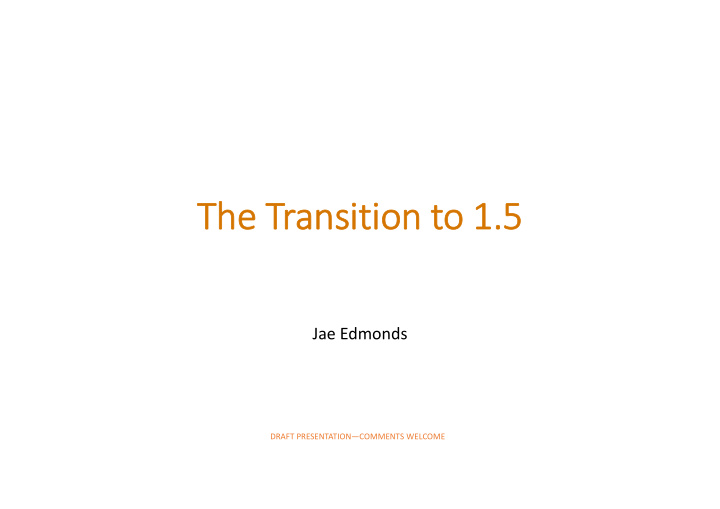



The The Tr Transition to to 1.5 1.5 Jae Edmonds DRAFT PRESENTATION—COMMENTS WELCOME
Framework Convention United Nations on Climate Change Article 2 (a) Holding the increase in the global average temperature to well below 2 °C above pre ‐ industrial levels and to pursue efforts to limit the temperature increase to 1.5 °C above pre ‐ industrial levels,…. Article 4 : In order to achieve the long ‐ term temperature goal set out in Article 2, Parties aim to […], achieve a balance between anthropogenic emissions by sources and removals by sinks of greenhouse gases in the second half of this century, on the basis of equity, and in the context of sustainable development and efforts to eradicate poverty . Courtesy: Jan Sigurd Fuglestvedt
Framework Convention United Nations on Climate Change • When the Paris Agreement was negotiated no scenario pathways had been developed that showed that 1.5 was possible. • That literature has grown rapidly since.
All CO 2 emissions scenarios are alike—They all end at zero • Cumulative emissions of CO 2 will determine climate CO 2 climate forcing— and climate—for the next century. • Non ‐ CO 2 emissions will become more important as CO 2 emissions decline to zero • CO 2 has no atmospheric sink—it doesn’t disappear • Carbon that was removed from the atmosphere over millions of years, can only be partitioned between atmosphere, ocean and land • Atmosphere (~20% on average will remain permanently) • Oceans (~80% on average will end up in oceans) 4 Representative Concentration Pathways and Extensions
Getting to Zero—Five strategy elements • Energy efficiency—reduce demand for energy as much as economical • Decarbonize power generation • Fossil fuel with CCS • Renewable power • Nuclear power • Bioenergy • Bioenergy with CCS • Electrify Buildings and Industry DRAFT PRESENTATION—DO NOT QUOTE, SUBJECT TO CHANGE as much as economical • Decarbonize transport • Electrify • Biofuels • H2 Source: http://www.energy.gov/science ‐ innovation/energy ‐ sources/renewable ‐ energy/wind • Halt deforestation/afforestation and continue improving crop yields 5 DRAFT PRESENTATION—COMMENTS WELCOME
Getting to zero—ALL sectors need to get close to zero or less DRAFT PRESENTATION—DO NOT QUOTE, SUBJECT TO CHANGE 6 DRAFT PRESENTATION—COMMENTS WELCOME Source: IPCC, AR5, SPM
The Challenge of Getting to 1.5 CO2 ‐ Radiative Avg. Global Temp. • CO 2 is measured in both equivalent Forcing Change Long ‐ term ( T)* tons of CO 2 and tons of C (W/m 2 ) (ppm) 6.8 o C • 3.667 ton CO 2 = 1 tons C 1360 8.5 (RCP) 5.6 o C 1030 7.0 • $1/tCO 2 = $3.67/tC 4.8 o C 850 6.0 (RCP) 650 4.5 (RCP) 3.6 o C CO 2 May 2019 414.7 PPM at NOAA’s 2.9 o C 550 3.7 2.1 o C 450 2.6 (RCP) Mauna Loa Atmospheric Baseline Observatory 1.5 o C 400 1.9 * Assumes a climate sensitivity of 3 o C. Climate sensitivity is the number of degrees the Preindustrial ~280 ppm planet would warm in the long term if the concentration of CO 2 doubled.
Remaining Carbon Budget • By the end of 2017, 2200 ± 320 GtCO 2 has been emitted by human activities • Currently, emitting 42 ± 3 GtCO 2 /yr Choice of the measure of global temperature affects the estimated remaining carbon budget Using global mean surface air temperature, as in IPCC AR5: 580 GtCO 2 left (50% chance of 1.5 °C) 420 GtCO 2 left (66% chance of 1.5 °C) Using global mean surface temperature (GMST) 770 GtCO 2 left (50% chance of 1.5 °C) 570 GtCO 2 left (66% chance of 1.5 °C) Courtesy: Jan Sigurd Fuglestvedt
Global emissions pathway characteristics Rapid reductions Net zero Negative emissions Courtesy: Jan Sigurd Fuglestvedt
Global emissions pathway characteristics Delayed action Negative emission Courtesy: Jan Sigurd Fuglestvedt
Global emissions pathway characteristics Courtesy: Jan Sigurd Fuglestvedt
Characteristics of Four Illustrative Pathways Low ‐ energy Sustainability Middle of the road Resource ‐ and demand focus – follows historical energy ‐ Source: Figure 2.5, IPCC SR1.5 patterns intensive
Source: Figure 2.15, IPCC SR1.5 The energy system will need to transform 2020 Primary Energy Sustainability Middle of the road – Resource ‐ and Low ‐ energy IEA Fast Trransition focus follows historical patterns energy ‐ intensive demand
Source: https://www.carbonbrief.org/look ‐ beyond ‐ emissions ‐ gap ‐ to ‐ see ‐ full ‐ force ‐ of ‐ climate ‐ pledges ‐ says ‐ unep ‐ report Progress to Date • Current policies and measures are not adequate to meet Nationally Determined Contributions (NDC) to Paris Agreement. • NDCs are inadequate to meeting either 2 o or 1.5 o long ‐ term stabilization goals.
Final Thoughts • Limiting climate change to any level involves eventually transitioning to a zero CO 2 emissions world – All sectors of energy and land systems must also decline toward zero or lower – All regions of the world must also decline toward zero or lower • Lower limits of global temperature require faster transitions • The challenge to achieving the 1.5 o goal should not be underestimated. – Global emissions must begin to decline before 2030 – Global carbon emissions must reach zero around 2050 – And then go negative . • Technology, policy and institutions will shape the mix of sectors and fuels. • The world is currently NOT on track to achieve the 1.5 o goal.
16 DISCUSSION
Recommend
More recommend